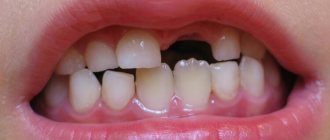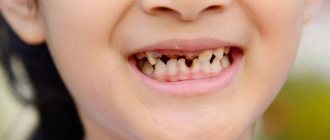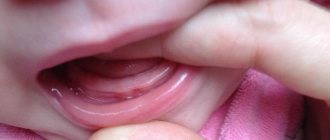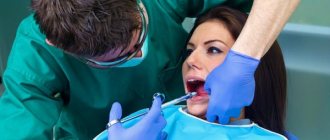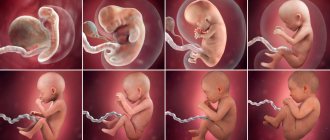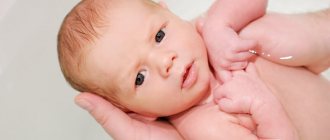Changing a child's baby teeth to molars is a completely natural process in the life of every child. It’s just when this period begins, when milk jugs begin to fall out, that every parent asks this question. Many mothers experience the emotional moment when their beloved children's milk jugs fall out. But you should really worry if problems suddenly begin to arise with the change from dairy to indigenous.
- 2 Scheme for replacing baby teeth
- 3 Care required for the oral cavity
3.1 Change of indigenous milkmen. Peculiarities
- 3.2 Factors that influence tooth stability
- 3.3 Malposition of permanent teeth and its causes
How do temporary teeth change?
It is a well-known fact that the normal number of teeth for an adult is 32. Why do children only have 20? The fact is that at 6 months, when the baby’s first teeth begin to erupt, his jaw is very small. As the child grows, it lengthens. And during the change period, two additional pairs of teeth appear on each jaw. They are called premolars and are located between the canines and molars. As a result, the number of teeth increases from 20 to 28. Where are the other 4? These are the so-called wisdom teeth, and they will grow much later, after 17 years.
The process of changing teeth is mostly painless. It turns out that temporary incisors, canines and molars have roots that dissolve over a certain period. As a result, baby teeth lose support, become loose and fall out one after another. They are replaced by molars, which have a denser structure, hard enamel and have greater endurance compared to temporary teeth. This is how a child’s body adapts to adult food. The order of loss of baby teeth in children, the diagram and timing of this process will be given below.
FAQ
Parents often have controversial questions regarding the replacement of baby teeth.
This is often caused by the presence of diseased teeth, which you want to quickly replace with strong, healthy ones. In this regard, it is possible to succinctly summarize the important information regarding primary and molar teeth. Are all baby teeth replaced by permanent teeth?
Yes all. The process of changing teeth is quite long, but all milk teeth will be replaced by permanent ones. In addition, at least four more molars will be added to them. The entire process of tooth growth should be completed by the age of 12-14 years. The remaining four wisdom teeth may grow throughout your life or may not grow at all.
Read also: When molars fall out in children
The photo shows the change of teeth in a child
How many baby teeth do children lose?
Children lose 20 baby teeth: eight incisors, four canines and eight molars. They differ significantly from permanent ones, as they are less bumpy. In addition, baby teeth have wider roots, since they are a protective block for the developing permanent ones.
Which teeth fall out first?
The first to fall out are the central incisors, and they can fall out both above and below; more often, the lower ones begin to fall out. Then - lateral incisors, canines and molars. The latter after the change are called premolars. In general, the pattern of tooth loss and growth is approximately the same as during the eruption of milk teeth.
An orthodontist will talk about how children's teeth change in this video.
The first signs of changing temporary teeth
Thanks to some signs, you can determine that a child will soon begin the process of losing baby teeth:
- The spaces between the teeth increase. Due to the lengthening of the growing jaw, temporary incisors, canines and molars find themselves at an increasing distance from each other. The reason to visit the dentist is that the child is already six years old, but the gaps have remained unchanged. To guide parents in terms of timing, a special scheme has been developed for the loss of baby teeth in children. The age and sequence of replacement are described there.
- Loose baby teeth. About two years before the temporary incisors, canines and molars begin to fall out, their roots begin to dissolve. As this process moves to the neck of the tooth, the latter gradually begins to wobble.
- Eruption of a permanent tooth next to the milk tooth. Sometimes it happens that a temporary incisor, canine or molar has not yet fallen out, but its root heir can already be seen nearby. Dentists consider this phenomenon harmless. And yet, in the case when a permanent tooth has erupted, but the milk tooth located next to it has not fallen out within three months, you should consult a dentist.
Reasons for untimely loss
There are cases when a child’s teeth fall out later than the specified period.
This may be due to poor nutrition, lack of useful microelements and vitamins in the body, frequent stressful situations, and various chronic diseases (for example, tonsillitis).
If at the age of 16-17 years there are still milk teeth in place of which the molars have not grown, you must definitely consult a dentist, since this phenomenon signals the presence of disorders in the human body.
Sometimes temporary teeth do not fall out on time due to the fact that the permanent ones have not yet fully formed. In addition, the following can be observed in some children: the baby tooth has not yet fallen out, but the molar tooth has already erupted and begun to grow, so-called “shark” teeth appear. In this state of affairs, parents should bring the child to see a doctor to have them carefully removed. This will help the roots grow correctly and evenly.
Among the reasons for late loss are the following:
- adentia – abnormal development of teeth, in which their rudiments have not formed during pregnancy;
- delayed physiological development of the child;
- abnormal growth of molars, despite the complete formation of the rudiments.
Fluoroscopy can help identify such problems. The absence of some molars or their rudiments will require further manipulation of prosthetics (temporary or permanent).
The condition of the dentition is also negatively affected by the very early loss of primary teeth. In their place, permanent ones should grow, displacing the dairy ones. If a tooth falls out before a certain time, the teeth that were on the sides begin to move to close the space between them. This can cause improper growth of molars.
The loss of baby teeth ahead of schedule depends on the following factors:
- jaw injury;
- malocclusion;
- pressure from nearby teeth;
- neoplasm increasing in size;
- necessary removal of a tooth due to its disease.
If the loss occurs prematurely, the space between the teeth can be “reserved” thanks to special plates that will prevent adjacent teeth from coming together. Thus, this device will hold space for the molar, which will grow a little later.
Doctors try to preserve temporary teeth until permanent teeth begin to emerge. Removal is resorted to only in cases where it can no longer be saved. If caries develops, the pediatric dentist provides the necessary treatment to help eliminate the problem.
If, after a tooth falls out, a new one begins to appear in its place, there is no need to worry; premature loss in this case is not a pathology and refers to the congenital hereditary characteristics of a person.
Have you heard about such a procedure as silvering baby teeth in children? Read about the benefits of this method. Does your child grind his teeth during the day? Perhaps it's bruxism. If you are interested, you can read in detail about this disease here.
Parents should explain to the child in advance that replacing baby teeth with permanent ones is a natural and painless process. Then children will not only cease to be afraid of the loss of temporary teeth, but will also look forward to the appearance of permanent ones.
To keep permanent teeth healthy and strong, it is necessary to instill in your child the desire to carefully and correctly carry out daily oral care procedures. It is necessary to start from a very early age so that careful attention to teeth becomes normal and commonplace.
Timing and order of loss of temporary teeth
Let's see how baby teeth are replaced by molars in children: at what age do they fall out? What is the replacement scheme? And how long does this process take? Experts say that the timing is individual for each child. The total duration of replacement of incisors, molars and canines is six to eight years. On average, the onset of hair loss in girls is six years of age, and in boys a little later. However, modern children are developing rapidly. Therefore, the pattern of loss of baby teeth in children can also be tied to the age of five. Also, the start date of the process of changing incisors, molars and canines and its duration depend on the genetic heredity of the child. The influence of climatic conditions, dietary habits and quality of drinking water is affected.
Below is a graphical representation of the sequence in which molars are replaced in children. The prolapse diagram, a photo of which is attached, shows that the incisors are replaced first, then the first molars, then the turn of the canines comes, and the last on the list are the second molars.
At six or seven years of age, when the process of changing “milk jugs” begins, the central incisors are the first to fall out. Moreover, first this happens to the teeth of the lower jaw (they are represented in the figure as number 1), and after them comes the turn of the upper teeth (number 2).
Next, the lateral incisors located on the upper jaw (number 3 in the image) fall out, followed by the same lower teeth (number 4). Their change occurs when the child turns seven or eight years old.
Then the pattern of loss of baby teeth in children involves the replacement of the first molars of the upper and lower jaws (shown in the figure as numbers 5 and 6). This occurs between the ages of nine and eleven years.
At the next nine to twelve years, according to the norm, the fangs of the upper jaw (number 7 in the image) should fall out, and after that the same teeth from below (shown as number 8).
Last, as evidenced by the pattern of loss of baby teeth in children, comes the second molars of the lower jaw (number 9 in the figure), and then the upper ones (number 10). This happens at ten to twelve years of age.
How many teeth do children change and at what age?
By the age of 2-2.5 years, most children have erupted all twenty baby teeth. After this, parents will have a quiet period when no changes occur in the child’s oral cavity. But after a few years they begin to wobble and fall out one by one, making room for the original ones. How exactly does this process occur and what is important for parents to take into account during the physiological change of teeth in children?
During the period of changing teeth, it is important to monitor the correct formation of the baby’s bite. How long does it take to change from baby teeth to molars?
All milk teeth, of which there are twenty, normally fall out so that in their place permanent teeth appear, which are called molars . At the same time , more permanent teeth erupt than there were milk teeth, since babies have an additional 2 pairs of chewing teeth. As a result, in childhood, instead of 20 milk teeth, 28 permanent teeth erupt.
There should be 32 molars in total, but the last four may begin to erupt later, and in some people they do not appear at all, remaining as rudiments in the gums.
Scheme: which ones and at what age change to permanent ones?
- The beginning of the shift is noted for most children at 5-6 years of age, when the child cuts his first molars. Because of their location in the dentition, they are called the “sixth tooth.” At the same time, from the age of 5, resorption of the roots of the primary incisors begins, a little later - the roots of the lateral incisors, and at 6-7 years - the roots of the first molars. This is a long process, taking on average 2 years.
- At 6-8 years old, children change their central incisors. First, a pair located on the lower jaw falls out, after which, on average, at 6-7 years of age, permanent incisors appear in their place, which are distinguished by their large size and the presence of a wavy edge. A little later, the central incisors located on the upper jaw fall out. The average time for permanent teeth to erupt in their place is 7-8 years.
- Next comes the period of changing the lateral incisors. On average, they fall out at 7-8 years of age - first on the upper jaw, and then on the lower jaw. Next, the lower pair of permanent lateral incisors begins to erupt, and at the age of 8-9 years, similar teeth appear on the upper jaw. Also, at the age of 7-8 years, the process of resorption of the roots of second molars and canines begins, which lasts on average 3 years.
- The next to change are the “fours” . They are called the first molars, but after they fall out, which occurs on average at 9-11 years of age, teeth “peck” in their place, which are called permanent first premolars. The first molars fall out first on the upper jaw, and then the turn of the lower teeth comes. However, permanent teeth are in no hurry to erupt in their place, giving way to fangs.
At the age of 9-12 years, children lose their primary fangs – first the upper ones, popularly called “eye teeth”, and then the lower ones. Permanent fangs begin to cut at the age of 9. Such teeth appear first on the lower jaw at the age of 9-10 years, and at the age of 10-11 years the upper permanent canines also erupt.
Between the ages of 10 and 12 years, the child's first premolars (fourth permanent teeth) erupt and the second molars (fifth baby teeth) fall out, followed by the eruption of the second premolars (fifth permanent teeth). The last four baby teeth fall out first on the lower jaw and then on the upper jaw. After this, only the permanent teeth remain in the child’s mouth. The lower permanent “fours” appear on average at 10-11 years, and in the period from 10 to 12 years, premolars (the fourth and fifth pairs of teeth) in the upper jaw are cut. At 11-12 years old they are supplemented by the lower pair of second premolars.
The last to be cut in childhood (on average from 11 to 13 years) are the second molars , called “sevens”. At the age of 11-12 they appear on the lower jaw, and at the age of 12-13 the upper “sevens” also appear.
Third molars, also called “eights” or “wisdom teeth,” appear later than all other teeth. This is often observed over the age of 17 years.
Sometimes molar premolars erupt when baby teeth have not yet fallen out
For a dialogue with S. Serbina, a pediatric orthodontist, watch the video below:
Until how many years do they change?
The change of teeth in children lasts quite a long time, starting at 5-6 years. In some children, it is completed before adolescence, but in most cases, by the age of 16-17, only 28 permanent teeth have erupted . Wisdom teeth erupt much later.
Are there those that don't change?
If we are talking about baby teeth, then they are all replaced by permanent ones. Some parents consider the chewing teeth, which are the last to erupt in the child (“fours” and “fives”), to be permanent and think that they will not change. However, this is not the case, and the fourth and fifth milk teeth on each side of the jaw should fall out in all children , and in their place permanent teeth appear, which are called “premolars.”
All the baby's baby teeth will definitely be replaced by molars. Do molars change in children?
Since molars are permanent teeth that erupt in children to replace milk teeth, they should not normally fall out. They remain with the children for the rest of their lives.
Oral hygiene during shift
While a child's teeth are changing, it is very important to carefully and regularly care for the oral cavity, since the enamel of new teeth is poorly mineralized and vulnerable to negative external influences.
The child should brush them twice a day with an age-appropriate toothbrush and the right toothpaste. It is also recommended to use special rinses and dental floss.
Oral hygiene should become a mandatory procedure in the morning and before bed. Tips
By protecting your baby from excessive consumption of sweets, you will keep his teeth healthy.
- As a rule, permanent teeth are cut without significant pain. If the child is worried about pain, you can use an anesthetic gel used for teething, but it is best to take your son or daughter to the doctor and make sure that the teething process is going well.
- If a tooth is very loose, it can be pulled out at home. To do this, grab it with a piece of sterile gauze, shake it to the sides and pull it down or up. If it does not respond, postpone the procedure or take your baby to the doctor.
- Since the enamel of newly erupted teeth is not strong enough, the first permanent teeth to appear are often affected by caries. “Sixes” are susceptible to this not only because of early teething, but also because of the presence of fissures - depressions on the chewing surface, from which it is difficult to remove plaque. For protection, a procedure called fissure sealing is often used. If you want to perform it on your child, take your child to the dentist as soon as the chewing surface of the sixth teeth is completely free from the gums.
- Remember that all periods of shedding and eruption are average. They may differ for each individual child, so with minor deviations there is no reason to worry. If the loss of a tooth or the appearance of a permanent one in its place is very late, go to the dentist.
- One of the very common problems during the transition period is the curvature of the erupting permanent teeth. If their position is incorrect, take your child for a consultation with an orthodontist. The use of special devices will help to level them.
Watch Dr. Komarovsky's program.
At the age of three years, a child already has all 20 baby teeth in his mouth. Some children can boast of such an achievement at 2 years old, others at 2.5 years old, but very rarely the process of teething lasts longer than the indicated age. After all the milk teeth have come out, a quiet period begins - painful, and often this is how it happens, teething has ended.
When children's teeth are replaced with permanent ones
But by the age of five, five and a half years, a new period begins: baby teeth become loose to give way to permanent ones, the so-called molars. And more of them appear than milk teeth - plus two pairs of chewing dental units grow in the child’s mouth, a total of 28 teeth, already permanent, will appear by the age of 12-13.
Changing baby teeth
And those same “wisdom teeth” will erupt later. Although not all people grow them: the last four may remain forever as the rudiments of dental units in the gums.
Why is it important to preserve primary teeth?
Baby teeth are more susceptible to the negative effects of caries than molars. And complications of this disease occur quite often. The child himself cannot realize that his tooth enamel is damaged. That is, to diagnose caries, a visit to the dentist is necessary. Parents should take this very seriously. After all, advanced diseases of baby teeth are a direct path to their loss, which in itself is a bad factor.
Temporary incisors, canines and molars are the “guardians” of space for their original replacements. If a temporary tooth is lost, its neighbors begin to move to fill the resulting void. Afterwards, the indigenous followers, who will grow in the place of the existing milk plants, will not have enough space for normal development, and they will creep on top of each other, forming an uneven row. It is also possible to disrupt their growth, shift to the side and form an incorrect bite.
Removal of a baby tooth at the dentist: possible reasons
A good pediatric dentist will never allow a baby tooth to be removed if it can be treated and saved. However, there are situations when this cannot be avoided. Removal of a temporary tooth is justified in the following cases:
- Severe destruction of the “milk jug” and the impossibility of its restoration.
- Presence of a basal cyst of a temporary tooth.
- The development of inflammation, which can subsequently lead to problems with the molar.
- Eruption of a permanent tooth when the baby tooth has not fallen out.
- Severe wobbling of a primary incisor, canine or molar, which causes pain and discomfort to the child.
When do baby teeth start to change?
The process of shedding and eruption occurs simultaneously, since they are very connected. The appearance of teeth occurs in the same sequence as their loss in the sequence presented:
- Incisors,
- First and second premolars,
- Fangs.
The growth of the first molars begins much earlier than the growth of the primary molars. And the appearance of second molars occurs in place, which were released when the jaw began to grow rapidly.
Another name for third molars is “wisdom teeth.” Many people are not familiar with this phenomenon at all. Sometimes problems begin when they erupt.
Premature loss of primary teeth
Above, the age range at which baby teeth are replaced in children and the pattern of loss were determined. 5 years is the time limit after which the loss of an incisor, canine or molar is no longer considered premature, despite the fact that the norm for starting the replacement of temporary teeth in pediatric dentistry is when a child reaches the age of six.
The reasons for premature loss of milk jugs may be as follows:
- Injury. The child lost a tooth as a result of mechanical impact (fall, blow).
- An abnormal bite, which in pediatric dentistry is designated by the term “deep.” The upper jaw covers the lower jaw, the teeth of which are subjected to excessive pressure, and there is a possibility of losing them.
- Pressure of neighboring teeth. This happens when the milk jugs have not grown properly. The reason for premature loss is similar to the previous point - excessive pressure on a temporary incisor, canine or molar.
- Caries in advanced condition. In this case, the baby tooth simply crumbles.
- Intentional loosening of a temporary incisor, canine or molar by a child.
How many change from dairy to indigenous?
All milk teeth, of which there are twenty, normally fall out so that in their place permanent teeth appear, which are called molars . At the same time , more permanent teeth erupt than there were milk teeth, since babies have an additional 2 pairs of chewing teeth. As a result, in childhood, instead of 20 milk teeth, 28 permanent teeth erupt.
Read also: When do molars erupt in children?
There should be 32 molars in total, but the last four may begin to erupt later, and in some people they do not appear at all, remaining as rudiments in the gums.
Delayed loss of primary teeth
There is a situation when milk teeth are in no hurry to fall out. The reason for this may be the child’s heredity, a history of severe infectious disease, rickets in the child, or an unbalanced diet and, as a result, a lack of vitamins and calcium in the body.
It is possible that the baby tooth has not yet fallen out, but its permanent replacement is already beginning to erupt next to it. This is called "shark teeth". There is nothing terrible, but only in the case when within three months the “milk jug” still gives way to a permanent tooth. Otherwise, a visit to the dentist is necessary.
Also, a trip to the dentist is necessary if the child is already eight years old and his baby teeth are still in place.
What to do after a temporary tooth falls out
Usually, the loss of a baby tooth is preceded by its loosening, so such a moment will not come as a surprise to the child. After the loss of a temporary canine, incisor or molar, a wound forms at the site where it grew. To stop the bleeding, apply a sterile cotton swab or gauze to the hole. After 3-5 minutes the bleeding will stop.
Within 2 hours after the loss, you should not feed the child, and after this time, you need to take warm food of a homogeneous composition for two to three days. Hard components and large fragments should be excluded to avoid injury to the unprotected area of the gum. After eating, you need to carefully rinse your mouth. The clot of dried blood that forms at the site of tooth loss will fall out on its own within two to three days. Removing it mechanically is strictly prohibited.
Baby teeth fall out: when and in what order?
Deadlines may vary. They depend on individual developmental characteristics. This process is long and most often painless and asymptomatic. The milky root gradually dissolves, then it begins to wobble and falls out. What should you pay attention to?
- Dentists recommend loosening and rocking baby teeth during their replacement period. Children can perform this procedure independently.
- A baby tooth can sit tightly and interfere with the growth of a permanent tooth. It is recommended to consult a dentist and remove the obstruction. If this is not done in a timely manner, the permanent one may grow crookedly or in the second row.
- After treatment, the milky roots dissolve slowly. More often than not they have to be removed.
- If the wound bleeds after a prolapse, have the child clamp a tampon or a piece of sterile bandage and hold it for several minutes. It is advisable not to eat for 2 hours after a tooth falls out or is removed. Let the child refrain from hot, cold, sour, salty foods. Do not allow the wound to be actively rinsed! A plug forms in the hole, which protects against the entry of microbes.
- Early loss occurs. What could this lead to? The free space in the jaw leads to the displacement of the remaining milk teeth, then the permanent teeth will begin to grow crookedly. Here a consultation with a pediatric orthodontist is necessary.
- The pattern of baby teeth loss in children is always the same. Usually, in the order in which teeth are cut, they fall out in the same order. In most cases, the process of loss begins in the lower jaw.
Read also: A child’s baby teeth are crumbling
Comparative analysis of primary and permanent dentition
Permanent teeth: features of eruption
The eruption of molars in children also follows a pattern. What should you pay attention to?
- Vulnerability. A child's permanent teeth have a larger pulp than an adult's. At the same time, hard tissues are just being formed, so they are easily exposed to external influences. This is especially true for the “sixes”. They suffer most often. Basic precautions: avoid foods that are too hard or sticky. This includes nuts, candies, and toffees.
- Period. It can take 4-6 months between the loss of a temporary tooth and the growth of a permanent one. This is the norm. If six months have passed and a permanent hole does not appear in the hole, you should definitely contact a specialist. The tooth may not have enough room to erupt.
- Growth rate. The front incisors grow quickly. Much slower - fangs. The growth of premolars and molars can be difficult and prolonged. The reason is the large area of eruption.
- Timing of eruption of permanent teeth in children: violations. The timing depends on heredity, developmental characteristics, and previous infections. The delay in eruption can be explained by a physiological reason: tooth buds have not yet formed. There is nothing dangerous about this. This is an individual feature. It is also possible that the tooth is positioned incorrectly in the bone tissue. These and other abnormalities can be detected by a doctor using x-ray diagnostics. What can violations lead to? For various defects: location outside the arch of the dentition, malocclusion, tilt, rotation, etc.
- Molars in children: temperature. Sometimes children may complain of soreness, swelling, itching of the gums, and general fatigue. Most often, the temperature rises when molars are cut. The reason is a large area of gum inflammation. The pain syndrome in this case also intensifies. If the temperature during molar teething exceeds 38 °C, it is better to give the child an antipyretic.
What not to do after a temporary tooth falls out
After the milk jug falls out, you should not let your child chew on very hard foods, such as nuts, crackers, and caramel. It is also prohibited to use antiseptics (hydrogen peroxide or alcohol solutions) to cauterize the resulting wound. Do not touch the bleeding hole with your fingers to prevent infection.
If, after the loss of a temporary incisor, canine or molar, a child has a fever, this is a reason to immediately contact a pediatrician. And during the period of changing baby teeth, you should contact the dentist at least twice a year for a preventive examination.
Do baby teeth need to be treated?
Caries is quite common in children of preschool and primary school age. To prevent it, caring parents should pay great attention to preventive measures.
Very often, parents are interested in why it is necessary to treat baby teeth if they are going to fall out anyway. It should be noted that caries is a disease and therefore requires treatment. If left untreated, undesirable consequences may occur:
- Early removal, which will lead to disruption of the formation of permanent occlusion,
- Chewing disorders, which will also lead to diseases of the gastrointestinal tract,
- Pulpitis and periodontitis, which can cause purulent inflammation in the head area - abscesses and phlegmons.
The first visit to the dentist should occur at the age of one year , when the first milk teeth have just begun to appear. The replacement of baby teeth with permanent teeth should be carried out under the supervision of specialists. At the first appointment, the doctor will be able to:
- Talk to parents
- Provide recommendations for caring for the child’s oral cavity,
- Adjust your diet.
The dentist schedules the next visit depending on the clinical situation.
If the first visit occurs at the age of 3-4 years, it is important to properly prepare children for this visit. Have a conversation with your baby about how the doctor will look at his mouth and clean it if necessary.
Parents and older children set a great positive example. The baby should get comfortable in the office, get to know the doctor and the environment. The appointment time must be chosen based on the individual characteristics of the child: for some, morning hours are more suitable, and for others, evening hours.
IMPORTANT : If a child is allergic, parents should take care in advance to conduct allergy tests for anesthetics and other drugs used in dental practice. Half an hour before your appointment, it is advisable to take an antihistamine drug.
If caries is detected during the appointment, and the child shows psychological readiness for treatment, the caries can be treated with special tips, which are used to treat the tooth cavity and place a filling. If the tooth is severely damaged, the doctor may recommend the installation of special dental metal crowns. They are placed on the chewing teeth and allow them to be preserved until children change their milk teeth to permanent ones.
Caring for your teeth during their replacement period
To keep baby teeth intact and healthy, the following is recommended:
- Brush your teeth using a soft brush twice a day.
- Get your baby used to rinsing his mouth every time he eats.
- Include dairy and fermented milk products in your child’s diet to enrich the body with calcium.
During the period of change of temporary incisors, canines and molars in a baby, adults ask the following questions: when do molars begin to replace baby teeth in children? Dropout pattern? And how long does this process take? The answers to them are in this article. The main thing for parents is to remember that they need to visit the pediatric dentist twice a year for a preventive examination in order to timely identify problems, if any. This will keep your baby's teeth beautiful and healthy.
Useful tips for parents
Take note:
- Prepare your child for a responsible process. Explain that instead of weak, “baby” teeth, he will have strong, permanent teeth like an adult. Often preschoolers compare the number of teeth that have fallen out and boast about each permanent unit;
- If a child is worried that everyone has lost 3-4 teeth, but he only has 2, explain that he shouldn’t look up to his friends. The main thing is that the process has begun;
- Dentists advise you to come up with a fairy tale about how a princess (knight, hero of your favorite cartoon) had all her teeth replaced. The child will know that there is no need to be ashamed of emptiness in the mouth or poor pronunciation of individual sounds when milk units fall out;
- When changing teeth, careful oral hygiene is required. The optimal time for brushing your teeth is after breakfast and before bed;
- The task of parents is to explain to their children the reasons why teeth deteriorate, to show by personal example the importance of hygiene procedures;
- The less preschoolers and schoolchildren consume sweets, chips, sour foods, baked goods, crackers, which provoke the destruction of dental tissue, the stronger the permanent units will be. The likelihood of developing caries will decrease several times;
- Remember that baby teeth also require treatment. Caries affects even non-permanent units. Go with your children to the doctor while the hole is small so that filling the cavity is not painful.
Most young parents strive to find out as many details as possible about the processes in the child’s body. Moms and dads are trying to figure out how to handle different situations.
Understanding how, when and in what way baby teeth are replaced by permanent teeth, knowledge of the pattern of tooth loss will be useful to all parents. Monitor the correctness of the teeth change, and if there are any deviations, visit the dentist. Grown-up children will probably thank you for a beautiful smile, because dental care needs to be taken care of from an early age.
Video – diagram of the loss of baby teeth and the eruption of permanent teeth:
